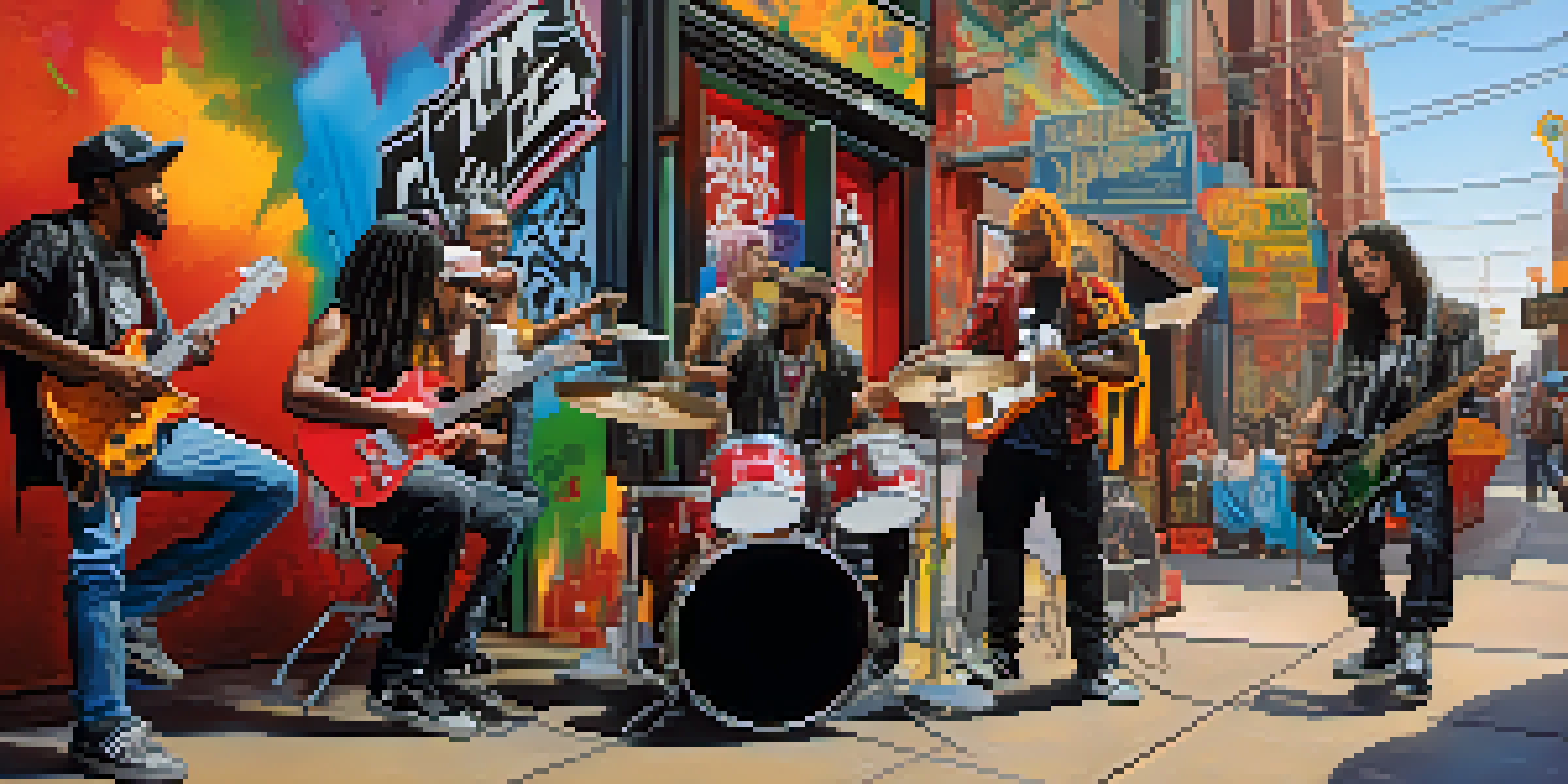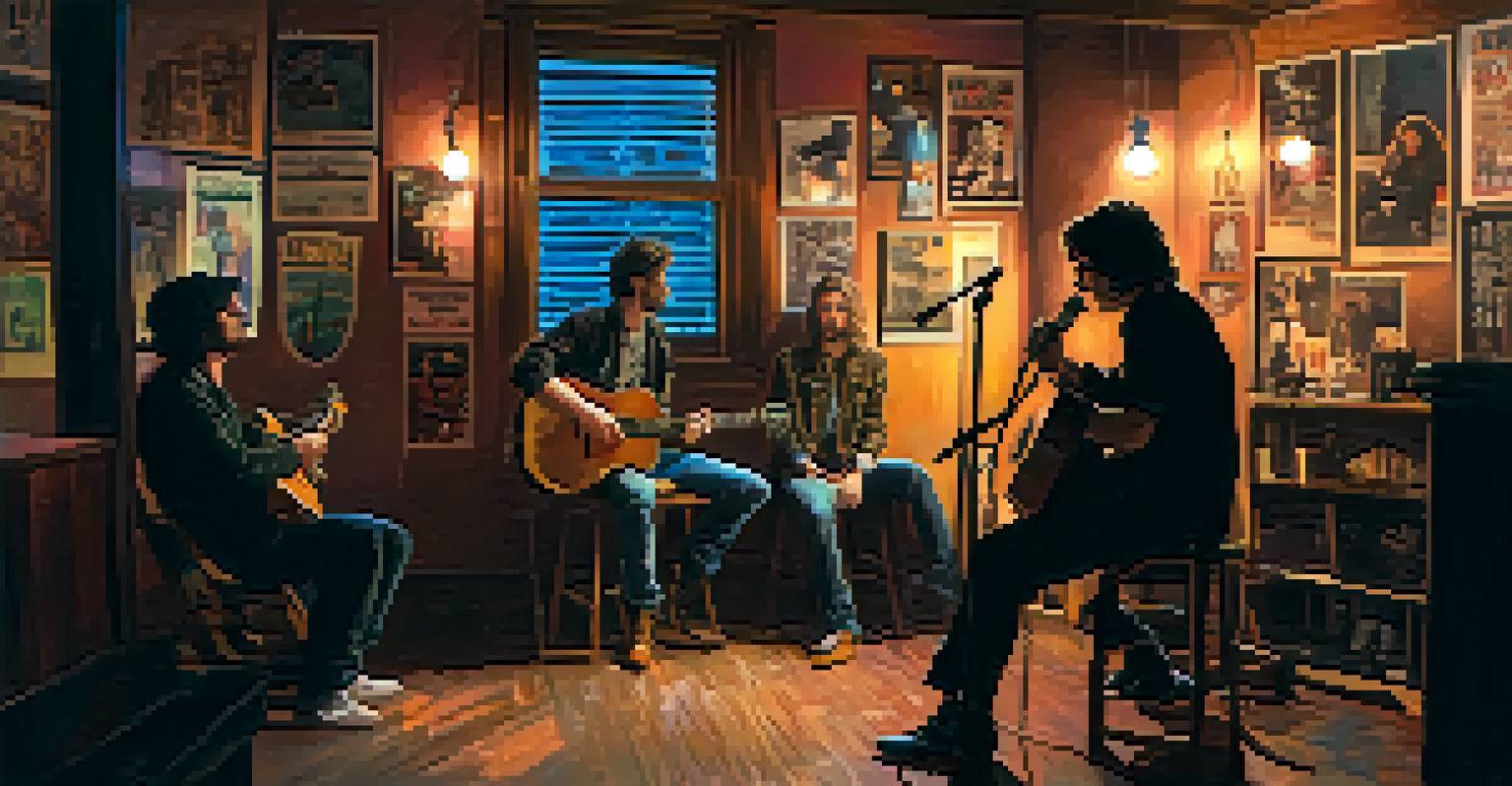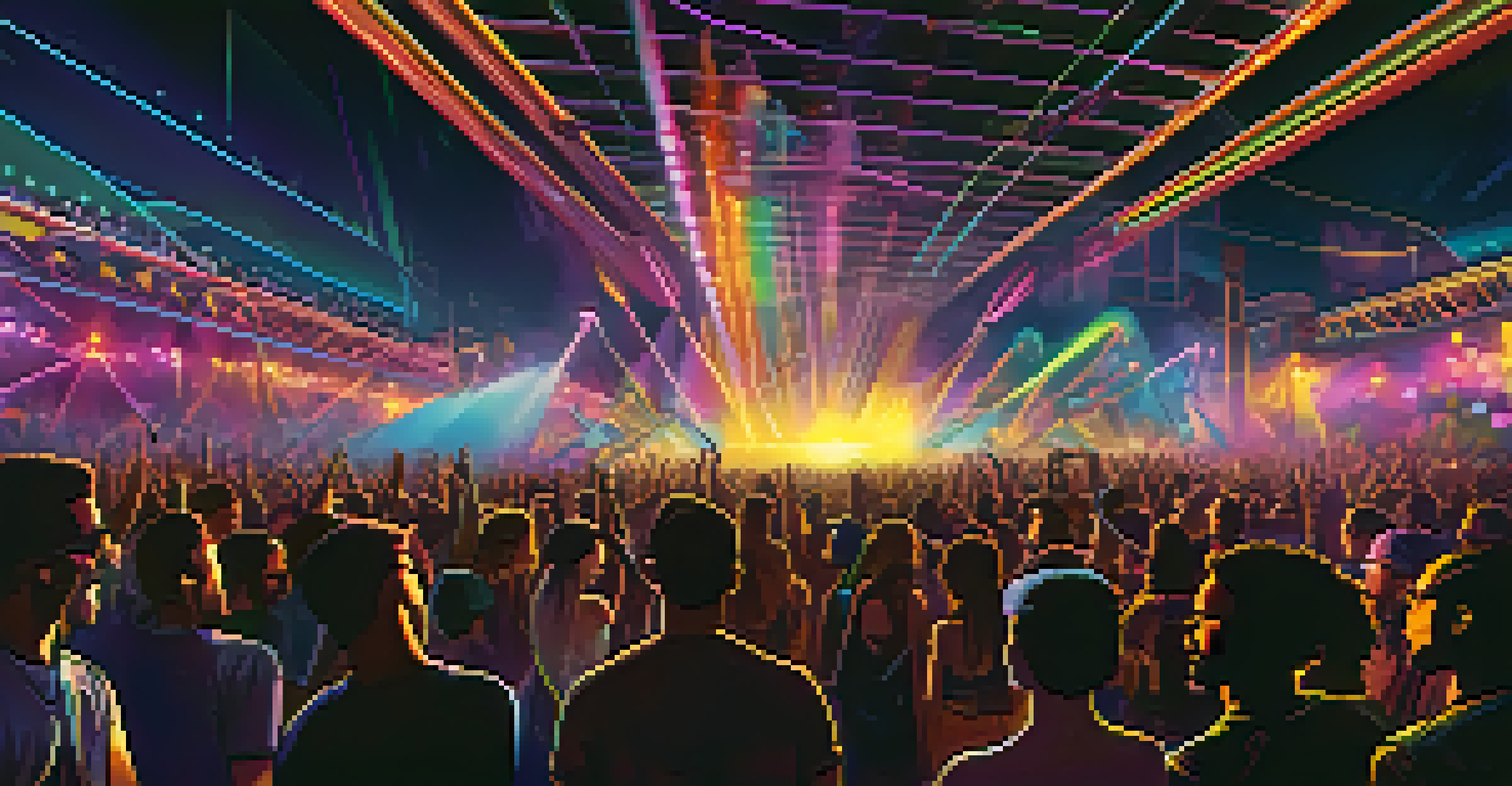Subcultures and Music: How They Shaped Popular Genres

Understanding Subcultures in Music
Subcultures are groups that share distinct values, beliefs, and practices, often emerging in response to mainstream culture. In music, these subcultures not only create unique sounds but also form communities that foster creativity and self-expression. Whether it’s punk, hip-hop, or goth, each subculture has its own identity that resonates with its members and influences wider musical trends.
Music is the shorthand of emotion.
For example, punk rock emerged in the 1970s as a reaction against both the music industry and societal norms. It wasn’t just about the sound; it was a lifestyle that embraced anti-establishment sentiments. This rebellious spirit has since seeped into various genres, encouraging artists to break free from conventional constraints.
Understanding these subcultures is crucial for grasping how they shape popular music. They serve as incubators for innovation, pushing the boundaries of creativity and inviting other genres to incorporate fresh elements.
The Punk Movement and Its Musical Legacy
The punk movement is a prime example of how a subculture can influence mainstream music. Emerging from the gritty streets of New York and London, punk rock was characterized by its raw sound and straightforward lyrics, often addressing political and social issues. Bands like The Ramones and Sex Pistols didn’t just create music; they sparked a cultural revolution that inspired countless artists.

As punk evolved, it gave birth to various subgenres, including pop-punk and post-punk, each adding new layers to the musical landscape. The ethos of DIY (do-it-yourself) culture from punk has encouraged many artists to take control of their creative processes, leading to a more diverse music scene. This legacy can still be seen today in the rise of independent artists and labels.
Subcultures Drive Musical Innovation
Distinct musical subcultures like punk and hip-hop foster creativity and self-expression, reshaping mainstream music.
Punk’s influence extends beyond music; it has shaped fashion, art, and even attitudes towards authority. Its impact is a testament to how powerful a subculture can be in redefining what popular music looks and sounds like.
Hip-Hop: A Voice from the Margins
Hip-hop emerged in the 1970s in the Bronx, born from the experiences of marginalized communities. It was a means of storytelling, where artists could express their struggles, triumphs, and aspirations through rhythm and rhyme. This subculture not only introduced a new musical style but also highlighted social issues, making it a powerful vehicle for change.
The fact that music can connect people from different cultures and backgrounds is one of the most beautiful things about it.
As hip-hop grew, it diversified into various styles, including trap, conscious rap, and alternative hip-hop. Each subgenre reflects different aspects of life and culture, showcasing the versatility of the genre. Artists like Nas and Kendrick Lamar have used their platforms to address systemic racism and inequality, resonating with audiences worldwide.
Today, hip-hop is one of the most influential music genres globally, shaping fashion, language, and even politics. Its roots in subculture remind us that music can be a catalyst for social commentary and transformation.
The Influence of Reggae and Rastafarian Culture
Reggae music, deeply intertwined with Rastafarian culture, emerged in Jamaica during the late 1960s. It carries messages of peace, love, and social justice, often addressing themes like oppression and spirituality. Artists like Bob Marley brought reggae to the global stage, highlighting how music can transcend borders and connect people.
Rastafarianism’s emphasis on community and resistance against oppression influenced reggae’s sound and lyrical content. The genre’s distinctive rhythm and use of instruments like the guitar and drums create a vibrant, uplifting atmosphere that encourages unity. This unique blend of spirituality and music has inspired countless artists across various genres.
Subcultures Influence Society
Genres such as reggae and goth not only create unique sounds but also address social issues, reflecting the power of music as a vehicle for change.
Reggae’s global impact is evident in its incorporation into pop, hip-hop, and other genres. It serves as a reminder of how subcultures can enrich the musical tapestry while advocating for important social issues.
Goth Culture: A Dark Aesthetic in Music
The goth subculture, known for its dark aesthetic and themes, originated in the late 1970s, primarily within the post-punk music scene. Bands like Bauhaus and Siouxsie and the Banshees created a haunting sound that resonated with those who felt like outsiders. This subculture embraced individuality, often expressing itself through music, fashion, and art.
Goth music is characterized by its somber melodies and introspective lyrics, exploring themes of love, loss, and existentialism. The blend of darkwave, industrial, and ethereal sounds has influenced various genres, leading to the emergence of new styles like dark pop and synth-pop. This evolution demonstrates how goth culture continues to inspire contemporary artists.
The goth movement has fostered a sense of community among its followers, who find solace in the music’s emotional depth. This connection illustrates the power of subcultures to create safe spaces for self-expression and acceptance.
Electronic Music: The Rise of Rave Culture
Electronic music, particularly the rave culture of the late 1980s and early 1990s, revolutionized the music scene. Originating in underground parties, this subculture embraced new technologies and sounds, encouraging creativity and collaboration among artists. Genres like techno, house, and trance became the soundtrack to these vibrant gatherings, promoting a sense of unity and freedom.
The rave scene’s emphasis on inclusivity and acceptance attracted a diverse audience, creating a melting pot of cultures and influences. This openness allowed for experimentation, leading to the emergence of various electronic subgenres. Artists like Daft Punk and The Chemical Brothers have since brought electronic music into the mainstream, showcasing its versatility.
Digital Age Transforms Music Landscape
Emerging platforms and genres showcase how subcultures continue to redefine musical norms and encourage artistic exploration.
Today, electronic music continues to shape popular genres, influencing everything from pop to hip-hop. The energy and innovative spirit of rave culture remind us of music’s ability to connect people and create unforgettable experiences.
Indie Music: A Reflection of Counterculture
Indie music emerged as a response to the commercialization of the music industry, championing artistic integrity and creative freedom. Rooted in DIY ethics, indie artists often produce and distribute their music independently, fostering a sense of authenticity. This subculture embraces diverse sounds, from folk to experimental rock, and has paved the way for a new generation of musicians.
The rise of platforms like Bandcamp and SoundCloud has allowed indie artists to reach global audiences without relying on traditional record labels. This shift has democratized the music industry, enabling unique voices to flourish. Bands like Arcade Fire and Bon Iver exemplify how indie music has made its mark while staying true to its roots.

Indie music’s influence can be seen in mainstream pop, where artists often blend genres and experiment with sounds. This cross-pollination illustrates the importance of subcultures in shaping the musical landscape, encouraging artists to explore their identities and push creative boundaries.
The Future of Subcultures and Music
As we look to the future, the relationship between subcultures and music continues to evolve. The digital age has created new avenues for artists to express themselves and connect with audiences, leading to a more interconnected musical landscape. Platforms like TikTok and Spotify have given rise to viral trends, often rooted in specific subcultures that influence popular music.
Emerging genres like hyperpop and lo-fi hip-hop demonstrate how subcultures can redefine musical norms. These genres often blend elements from various styles, reflecting the diversity of their creators and audiences. As artists continue to explore new sounds, the influence of subcultures will undoubtedly remain a driving force in shaping popular music.
Ultimately, the future of music lies in the hands of those who dare to challenge conventions and embrace their unique identities. By celebrating subcultures, we can continue to foster creativity and innovation, ensuring that the musical landscape remains vibrant and diverse.